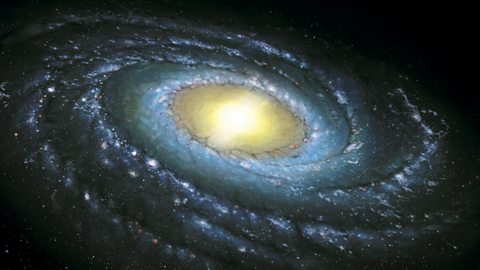Stars and galaxies
Our Sun is a starA large mass at the centre of a Solar System (if there are other bodies present) that produces heat and light, eg the star at the centre of our Solar System is called the Sun.. It seems much bigger than other stars in the sky because it is much closer to Earth. Stars form immense groups called galaxies. A galaxyA cluster of billions of stars, held together by gravity. can contain many millions of stars, held together by the force of gravityThe force of attraction between all objects. The more mass an object has, the larger the force of gravity it exerts..
Our Sun is in a spiral galaxy called the Milky Way. The Sun is about half-way from the centre of the galaxy, on one of the arms.

The light year
The distances between objects in space are huge:
- the distance from one star to another in a galaxy is millions of times more than the distance between the planets in the solar system
- the distance from one galaxy to another is millions of times more than the distance between the stars in a galaxy
This means that the numbers used to describe distances in space become very difficult to understand and to write down. For example, the distance between the Earth and the Sun is about 150,000,000,000 m but the distance to the next nearest star (Proxima Centauri) is 39,900,000,000,000,000 m.
To get around this problem, scientists use the light yearThe distance travelled by light in one year - a very large distance, usually used to describe distances between stars. The closest star to our own is about 4.3 light years away. as the unit of astronomical distance. It is the distance travelled by light in one year. So, for example:
- Sun to Proxima Centauri distance is about 4.24 light years
- Milky Way to Andromeda (the next nearest spiral galaxy) distance is about 2.5 million light years
It takes light from our Sun about 8 minutes to reach the Earth.